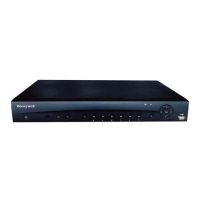
Do you have a question about the Honeywell HRHH1166 and is the answer not in the manual?
| Recording Resolution | Up to 1080p |
|---|---|
| Operating System | Embedded Linux |
| Compression | H.264 |
| Video Input | 16 channels |
| Hard Drive Support | Up to 6TB |
| Remote Viewing | Web browser, mobile app |
| Network Interface | RJ45 10/100 Mbps |
Information regarding compliance with regulatory standards and FCC statements.
Details the physical interfaces and components on the front and rear panels of the DVR.
Explains how to use the mouse for navigating the DVR's interface and its functions.
Outlines the basic operations and button functions of the IR remote control.
Lists the items included with the DVR package and instructions for initial unpacking.
Step-by-step guide for connecting cameras, monitors, mice, and network cables.
Procedures for safely powering the DVR on and off to prevent data loss.
Guides the user through initial DVR configuration using the automated startup wizard.
Describes the DVR's primary monitoring mode, displaying real-time video feeds.
Details how to adjust screen layouts, customize monitor picture settings, and manage views.
Instructions for operating PTZ cameras, including presets, tours, and patterns.
How to manually record video clips directly to a connected USB storage device.
Explains how to configure scheduled and event-triggered video recording for all channels.
Guide to searching recorded video by date, time, and event type, and playback controls.
Instructions for searching and viewing recorded snapshot images.
Procedures for saving recorded video clips and snapshots to external USB storage.
Adjusts camera image parameters like saturation, brightness, contrast, and sharpness.
Configures video and audio encoding parameters such as resolution, frame rate, and bit rate.
Sets up parameters for capturing still images based on schedules or events.
Allows blocking specific areas of the video feed for privacy or security reasons.
Customizes text and time displays on the video feed for each channel.
Renames cameras from default labels to descriptive names for easier identification.
Modifies the channel input type from Coax to UTP based on cabling used.
Sets up IP addressing, subnet masks, gateways, and network ports for connectivity.
Manages Wi-Fi connections, including automatic connections and hotspot searching.
Configures PPPoE, DDNS, IP Filtering, Email, FTP, UPnP, SNMP, Multicast, and Auto Registration.
Sets up the DVR to communicate with an alarm platform for event reporting.
Defines motion detection regions, sensitivity, thresholds, and associated actions.
Sets up detection and actions for when a video signal is lost from a camera.
Configures sensitivity and actions for detecting tampering with camera video feeds.
Manages notifications for HDD errors (disk full, error, no disk) and network errors (disconnection, IP conflict).
Configures local alarm inputs, including type, name, and detection periods.
Sets up alarm output types (Schedule, Manual, Stop) for triggering external devices.
Defines video recording schedules based on time, day, and event type (Regular, MD, Alarm).
Manages hard drive configurations, including type (read-write/read-only) and formatting.
Enables or disables snapshot recording for each channel.
Runs diagnostic tests on the HDD to check its health and performance.
Configures device name, language, video standard, HDD full behavior, and auto logout.
Adjusts GUI transparency, time/channel display, resolution, and preview enhancement.
Configures serial port settings for connecting external RS232 devices.
Links to PTZ connection settings for controlling PTZ cameras.
Manages settings for overlaying ATM/POS data onto video feeds.
Manages user accounts, groups, and their access privileges for the DVR.
Schedules automatic DVR reboots and deletion of old files for system upkeep.
Allows saving and loading DVR configurations to/from USB devices for backup or deployment.
Resets specific or all system settings back to their factory default values.
Instructions for updating the DVR's system firmware locally via USB.
Displays HDD status, record information, data stream rates, and system version details.
Shows event logs and status at both device and channel levels, with refresh capability.
Monitors online users, network data transmission, load, and performs network tests.
Accesses system, config, storage, alarm, record, and account logs for auditing.
Pre-connection guidelines and considerations for alarm input/output modes and wiring.
Describes the physical connections for alarm inputs and outputs on the DVR's rear panel.
Provides instructions and recommendations for properly connecting alarm input devices.
Offers guidance on connecting external alarm output devices and their specifications.
Step-by-step instructions for physically installing an additional HDD into the DVR.
A comprehensive list of compatible SATA hard drive models and their capacities.
A list of compatible portable hard drive models and their capacities.











